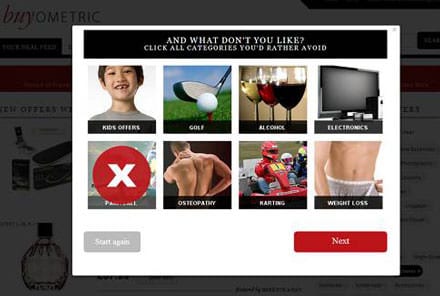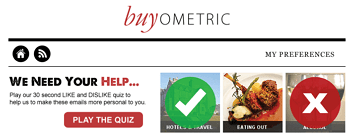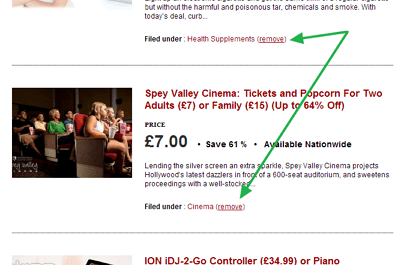Buyometrics’ success formula for 7% click rates on daily emails
Email campaigns with unique open rates of 30% and unique click rates of 7% beat email marketing benchmarks and represent great performance that any campaign manager would be happy with. Now try doing that for a daily email across your entire customer database...
That’s harder, but it’s a reality for the Buyometric Daily Deal campaigns. Buyometric are letting me lift the lid on their success formula.
The corner-stone is using highly dynamic and automated deal content targeting driven from a predictive algorithm which factors in several signals about what will most likely appeal to subscribers.
It starts with collecting user preference information after signup. Providing preference information is optional after the signup, yet Buyometric get a massive 78% of new signups to complete this optional step. Its all down to the incredibly smooth user experience, I’ve previously posted about how this works but to really get it, you’ve got to try it, so go and signup now (and unsubscribe afterwards unless you want to see the daily deals).

The preference process collects details of categories of deals liked and dis-liked. Only three likes are requested whereas the customer can dislike an unlimited number of categories. This makes sense as people tend to have more clarity about those things in which they could never imagine having an interest than those they do.
The Buyometric algorithm then uses the preference information to order and target which deals to include for each individual subscriber. However the matching of the most relevant deals doesn’t end there, the algorithm also factors in
- Subscriber click behaviour – what categories have they actually clicked and browsed
- Deal uniqueness – Buyometric check their database of deals and anything which is unusual to find as a deal is given priority.
- Brand value and quality – the reputation of the brand offering the deal
You might be wondering what happens to the 22% of signups that don’t provide preference data? They are still sent daily emails and the deals are targeted by learning over time.
The segment with no customer preference information enables some additional insight. By comparing the performance of the two segments with and without preference data, we get a measure of the value of the preference data.
Over the first couple of weeks new subscribers who complete the preference process are 3 times more likely to open and click one of the daily emails. Remember those that didn’t complete the preference process still did complete a double opt-in, so the reduction in opens and clicks is not because they didn’t want the daily emails, it is fair to say the improvement is due to better targeting.
As time progresses the targeting algorithm learns even for the subscribers who didn’t complete preference information. So after about 3 months the performance of subscribers with no preference has reached that of subscribers with preference.

As getting preference information provides a three times improvement for new subscribers, it’s clearly valuable to gain this insight to get subscriber engagement during the very important stage at the start of the relationship. So in the normal emails sent to new subscribers there is a top welcome panel with a call to action to complete preferences.
 The Buyometric emails include ‘remove’ links to allow customers to tailor the deals directly in the email. Clicking a ‘remove’ link updates the customer preference to dislike that category of deal. Seems a great idea, however, these links are attracting few clicks, possibly because customers don’t understand their purpose and the value of clicking. Buyometric are planning some more tests in this area to find a good user experience way to let customers intuitively tweak the deals they receive.
The Buyometric emails include ‘remove’ links to allow customers to tailor the deals directly in the email. Clicking a ‘remove’ link updates the customer preference to dislike that category of deal. Seems a great idea, however, these links are attracting few clicks, possibly because customers don’t understand their purpose and the value of clicking. Buyometric are planning some more tests in this area to find a good user experience way to let customers intuitively tweak the deals they receive.
Acknowledgement: My thanks to Andy Atkin-Berry, founder of Buyometric for permitting me to publish this information.







